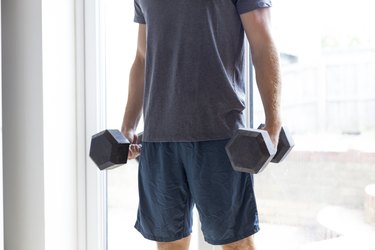
Looking to strengthen your upper body and build well-rounded shoulders and upper back? Or maybe you want to fix your posture and sit straighter with more comfort.
No matter your goal, the dumbbell rear delt fly can give you the physique and/or strength you're looking for. But if you want to reap the rewards, you need to make sure you're practicing good form. To finally get your rear delt fly right, avoid these five common mistakes.
Video of the Day
Video of the Day
1. Shrugging Your Shoulders
Your rear deltoids are a small muscle that's hard to target. When you first start performing the rear delt fly, you might notice your shoulders shrug up toward your ears while you lift the dumbbells, says New York-based physical therapist Sam Becourtney, DPT, CSCS.
Although it's a common mistake Becourtney sees with clients, hunching the shoulders can cause the neck to feel sore during and after training. You may even start to feel shoulder pain over time.
Fix It
"Think about pulling the shoulder blades down and back while you lift the arms up to avoid bringing your shoulders up to your ears," Becourtney says. Since you don't want to look up into a mirror while you do the rear delt fly, you can film yourself and double check your form.
2. Rounding the Lower Back
Considering the rear delt fly is performed in a bent-over position (unless you're using a cable machine or pec deck), another typical error Becourtney sees is a rounded lower back, especially toward the end of a set.
But you want to keep your back flat and long while you hold the hip-hinge posture. Lifting with a rounded back can lead to back pain over time as you start to lift heavier dumbbells, according to Becourtney.
Fix It
If you struggle to keep your back flat while standing, do this move seated but maintain the hip hinge and flat back.
"Rather than just folding and bending over, you're maintaining a relatively neutral spine as you bring the chest down and actively engage the abs and glutes during the exercise," Becourtney says.
3. Hyperextending the Wrists
As you lift your dumbbells up, it may feel natural to bend your wrist up (aka hyperextension) toward the ceiling. This may look and seem like proper form, but that's not the case.
"[Hyperextending the wrists] will look like you've achieved full range of motion but will end up stopping the exercise before your shoulders are truly engaged," Becourtney said.
This places a lot of tension on the joints and may cause wrist pain or stiffness during and after your workout, Becourtney says. Not to mention, your rear shoulder muscles aren't working as hard as they should be since they're unable to fully engage.
Fix It
Keep your wrists in a neutral position with the palms facing down, Becourtney says. Think about squeezing your shoulder blades together to lift the weights, rather than reaching back with your hands.
Related Reading
4. Bending or Locking Your Elbows
Your elbow position is the key to getting all the muscle-building benefits this move has to offer. As you raise the dumbbells, you should lead with your elbows to activate the rear delt, but you don't want to lock out or bend your arms too much.
"Locking out the elbows may put excessive strain through the elbow joint," Becourtney says. "Bending too much, on the other hand, can take away from the primary muscle you're targeting and excessively recruit the biceps to compensate."
Fix It
"Maintain a slight, but not excessive elbow bend. Think 10 to 15 degrees away from fully straight," Becourtney says. "Drop the weight if necessary to allow for a more controlled motion."
5. Lifting Too Quickly
To get the most from strength-training exercises, your muscles have to put in a challenging amount of effort. But when you lift too quickly, momentum takes over moving the weight. As a result, your muscles don't get as much benefit, according to the National Academy of Sports Medicine (NASM).
The longer you hold your rear delts contracted, the more your muscles grow, per the American Council on Exercise (ACE). Keeping your muscles under tension for longer periods of time increases the amount of damage to the muscle fibers, which encourages strength gain.
Fix It
Keep your reps slow and controlled, per the NASM. Pause at the top of the motion and lower your weights slowly. If you're unable to do this, grab lighter dumbbells.